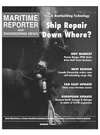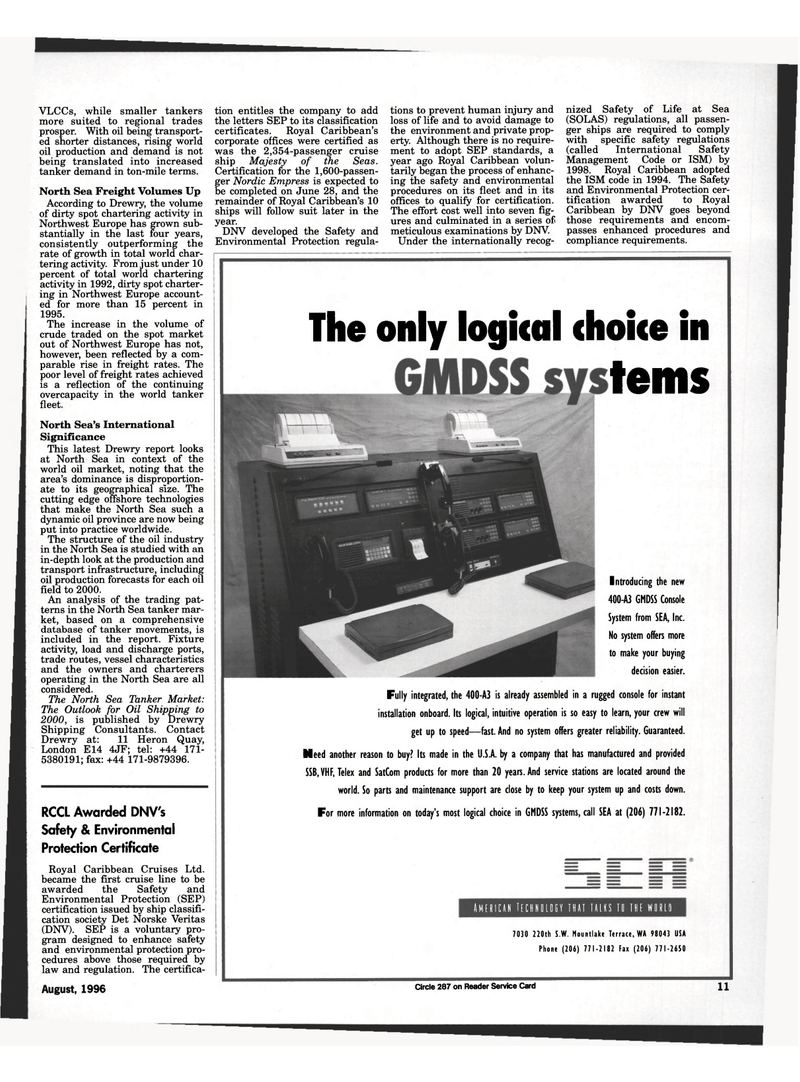
Page 9: of Maritime Reporter Magazine (August 1996)
Read this page in Pdf, Flash or Html5 edition of August 1996 Maritime Reporter Magazine
VLCCs, while smaller tankers more suited to regional trades prosper. With oil being transport- ed shorter distances, rising world oil production and demand is not being translated into increased tanker demand in ton-mile terms.
North Sea Freight Volumes Up
According to Drewry, the volume of dirty spot chartering activity in
Northwest Europe has grown sub- stantially in the last four years, consistently outperforming the rate of growth in total world char- tering activity. From just under 10 percent of total world chartering activity in 1992, dirty spot charter- ing in Northwest Europe account- ed for more than 15 percent in 1995.
The increase in the volume of crude traded on the spot market out of Northwest Europe has not, however, been reflected by a com- parable rise in freight rates. The poor level of freight rates achieved is a reflection of the continuing overcapacity in the world tanker fleet.
North Sea's International
Significance
This latest Drewry report looks at North Sea in context of the world oil market, noting that the area's dominance is disproportion- ate to its geographical size. The cutting edge offshore technologies that make the North Sea such a dynamic oil province are now being put into practice worldwide.
The structure of the oil industry in the North Sea is studied with an in-depth look at the production and transport infrastructure, including oil production forecasts for each oil field to 2000.
An analysis of the trading pat- terns in the North Sea tanker mar- ket, based on a comprehensive database of tanker movements, is included in the report. Fixture activity, load and discharge ports, trade routes, vessel characteristics and the owners and charterers operating in the North Sea are all considered.
The North Sea Tanker Market:
The Outlook for Oil Shipping to 2000, is published by Drewry
Shipping Consultants. Contact
Drewry at: 11 Heron Quay,
London E14 4JF; tel: +44 171- 5380191; fax: +44 171-9879396. tion entitles the company to add the letters SEP to its classification certificates. Royal Caribbean's corporate offices were certified as was the 2,354-passenger cruise ship Majesty of the Seas.
Certification for the 1,600-passen- ger Nordic Empress is expected to be completed on June 28, and the remainder of Royal Caribbean's 10 ships will follow suit later in the year.
DNV developed the Safety and
Environmental Protection regula- tions to prevent human injury and loss of life and to avoid damage to the environment and private prop- erty. Although there is no require- ment to adopt SEP standards, a year ago Royal Caribbean volun- tarily began the process of enhanc- ing the safety and environmental procedures on its fleet and in its offices to qualify for certification.
The effort cost well into seven fig- ures and culminated in a series of meticulous examinations by DNV.
Under the internationally recog- nized Safety of Life at Sea (SOLAS) regulations, all passen- ger ships are required to comply with specific safety regulations (called International Safety
Management Code or ISM) by 1998. Royal Caribbean adopted the ISM code in 1994. The Safety and Environmental Protection cer- tification awarded to Royal
Caribbean by DNV goes beyond those requirements and encom- passes enhanced procedures and compliance requirements.
RCCL Awarded DNV's
Safety & Environmental
Protection Certificate
Royal Caribbean Cruises Ltd. became the first cruise line to be awarded the Safety and
Environmental Protection (SEP) certification issued by ship classifi- cation society Det Norske Veritas (DNV). SEP is a voluntary pro- gram designed to enhance safety and environmental protection pro- cedures above those required by law and regulation. The certifica-
American technology that talks to the Wdrla
The only logical choice in tems 7030 220th S.W. Mountlake Terrace, WA 98043 USA
Phone (206) 771-2182 Fax (206) 77I-26S0
Introducing the new 400-A3 GMDSS Console
System from SEA, Inc.
No system offers more to make your buying decision easier.
Fully integrated, the 400-A3 is already assembled in a rugged console for instant installation onboard. Its logical, intuitive operation is so easy to learn, your crew will get up to speed—fast. And no system offers greater reliability. Guaranteed.
Need another reason to buy? Its made in the U.S.A. by a company that has manufactured and provided
SSB.VHF, Telex and SatCom products for more than 20 years. And service stations are located around the world. So parts and maintenance support are close by to keep your system up and costs down.
For more information on today's most logical choice in GMDSS systems, call SEA at (206) 771-2182.
August, 1996 Circle 287 on Reader Service Card 11

 8
8

 10
10
